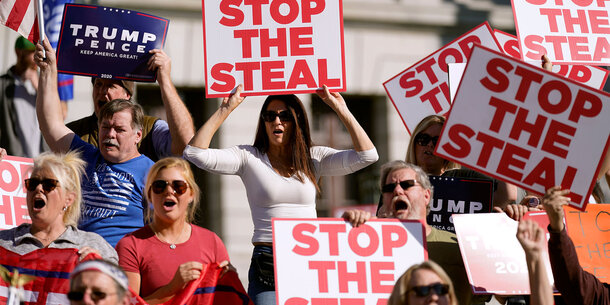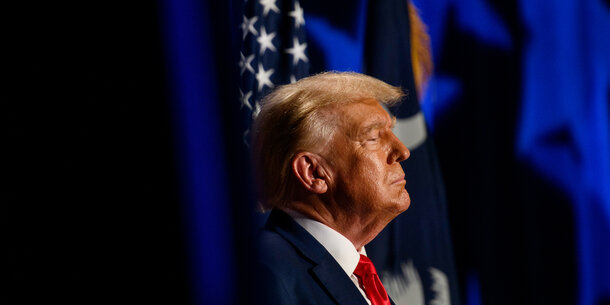Moore v. Harper at the High Court
The justices hear the landmark elections case.

You’re reading The Briefing, Michael Waldman’s weekly newsletter. Click here to receive it every week in your inbox.
Wednesday morning, the Supreme Court heard oral arguments in Moore v. Harper. Prominent conservative judge J. Michael Luttig, raising an alarm, called it “the most important case, since the founding, for American democracy.” Let’s hope not.
After all, the Supreme Court should rule — decisively, and unanimously — that this fringe notion is not the law of the land, never has been, and never will be.
Regular readers know the facts: the Court is being asked to rule that the U.S. Constitution gives state legislatures exclusive power over redistricting and election rules, with no checks and balances from state constitutions, state courts, governors, or voters via ballot measures.
Often, lawyers try to come up with scary hypotheticals to show the logic of an argument. Here, the facts of Moore v. Harper are scary enough. North Carolina is narrowly divided between the parties. Yet the legislature produced a gerrymandered congressional map with eleven Republican seats and just four Democratic ones. The state supreme court struck it down for violating the North Carolina constitution. The legislature now says that state courts and constitutions have no role in redistricting — state lawmakers can do whatever they want when it comes to federal elections.
It’s a breathtaking claim, and it’s made up. It’s not a “theory” — as NYU Law professor Melissa Murray puts it, it’s fan fiction. No state runs its affairs that way. The U.S. Supreme Court has rejected it repeatedly. James Madison would flip his powdered wig.
The amicus (“friend of the court”) briefs against the legislature’s claim have been fairly overwhelming. The cofounder of the Federalist Society. George W. Bush’s lawyer in the Florida recount. Every single historian and scholar of note, led by Rosemarie Zagarri of George Mason and Jack Rakove of Stanford. Republican and Democratic politicians and election officials. All have weighed in.
The chief judges of all fifty state courts wrote with alarm that this would cut out their key role in protecting voting rights. It’s a core federalism argument.
This Court, of course, likes to say it is originalist. The provision now under debate — the Elections Clause — was put in the Constitution by James Madison precisely because the Founders did not trust state legislatures, thinking they would be captured by “factions” and would gerrymander and engage in vote suppression. (They did not use those words.) Madison explained at the Constitutional Convention that “it was impossible to foresee all the abuses” legislators would try to enact. Indeed, those worries were among the main reasons the Founders convened in Philadelphia in the first place. They wouldn’t have adopted a clause giving state legislatures unfettered power over elections. They knew full well there were state constitutions — in fact, they were really proud of that fact. The history for the independent state legislature theory’s claim is so threadbare that advocates have resorted to citing phony historical documents.
The justices also purport to be “textualists.” The Constitution says the “legislature” sets the “times, places, and manner” of federal elections but that “Congress may at any time by Law make or alter” those rules. Nobody would argue that the use of “Congress” means presidents can’t sign or veto election laws, or that the U.S. Constitution doesn’t apply, or that the Supreme Court can’t judge the constitutionality of a federal voting statute. Yet that’s literally what the theory’s supporters argue about the use of “legislature” in the first half of the sentence. If “Congress” were interpreted this way, then lawmakers could raise or cut taxes without worrying about presidents signing or vetoing. This is sophistry, and not very sophisticated sophistry at that.
Proponents of the independent state legislatures have tried to scramble and backtrack: Surely there’s a middle path, a “lite” version of the theory. Actually, there isn’t.
They claim there’s some difference between state constitutional rules that govern procedure and those that limit substance. In reality, there’s no difference, and assigning federal judges the job of sorting that out is a recipe for clogged and chaotic courts. It’s nutty to say that citizens of a state could adopt a provision requiring a secret ballot, say, but not “free and fair elections,” as so many constitutions do.
The nine justices should remember that their ruling will have concrete and possibly catastrophic consequences in the real world. The Brennan Center’s brief catalogs all the court rulings, constitutional provisions, and rules that would be struck down if the Court acts unwisely. It would be sheer chaos.
My colleagues Eliza Sweren-Becker and Ethan Herenstein explain here the many logical flaws and incoherence of these watered-down versions of the independent state legislature theory. But notice this about the proposals: every one of them takes important powers away from governors, judges, and the voters themselves and concentrates power in the hands of state legislatures.
The Supreme Court justices have a chance to speak clearly — when it comes to this kind of tendentious power grab, they should just say no.





